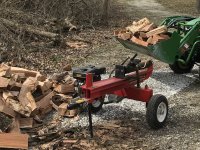PILOON
Super Star Member
Well mine is a 3 point DIY affair.
Cost me a 5 ft 6 x 6 H beam, a valve and a $25.00 5" 'dozer hydraulic cylinder plus some fun time creating my 3 point unit.
No oil to change as it is 'plug and play'.
Not the fastest but still faster than I can feed it. (@ 80 I've kind of slowed down a bit.)
Power to spare as I can cut 5" hard maple cross grain, (LOL, one way to test my welding skills).
Cost me a 5 ft 6 x 6 H beam, a valve and a $25.00 5" 'dozer hydraulic cylinder plus some fun time creating my 3 point unit.
No oil to change as it is 'plug and play'.
Not the fastest but still faster than I can feed it. (@ 80 I've kind of slowed down a bit.)
Power to spare as I can cut 5" hard maple cross grain, (LOL, one way to test my welding skills).


